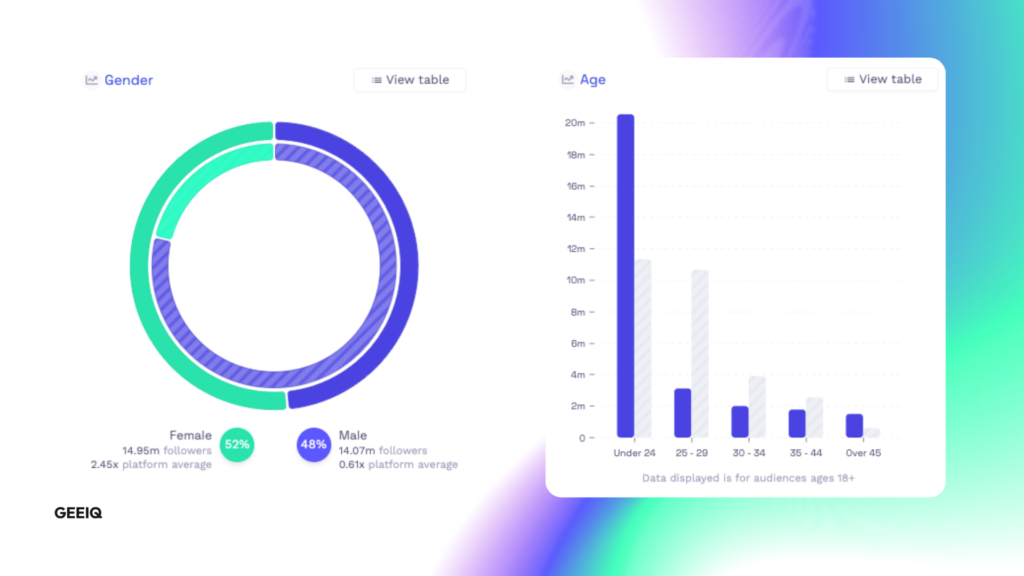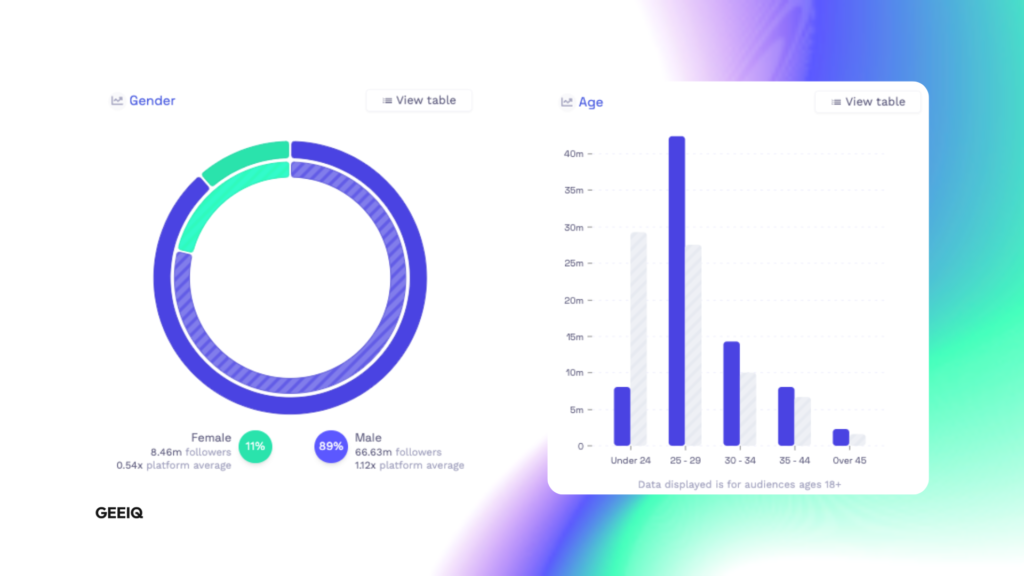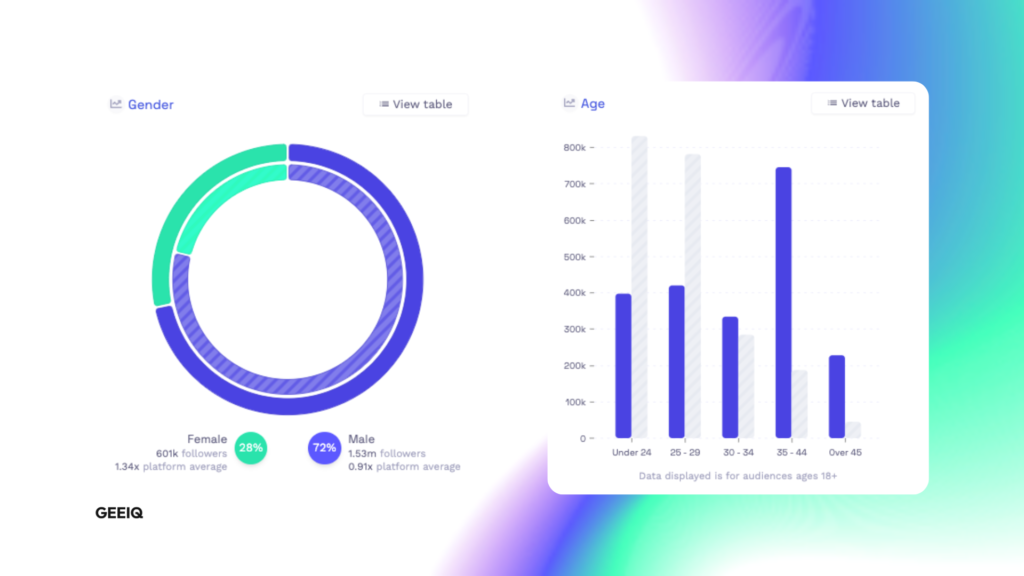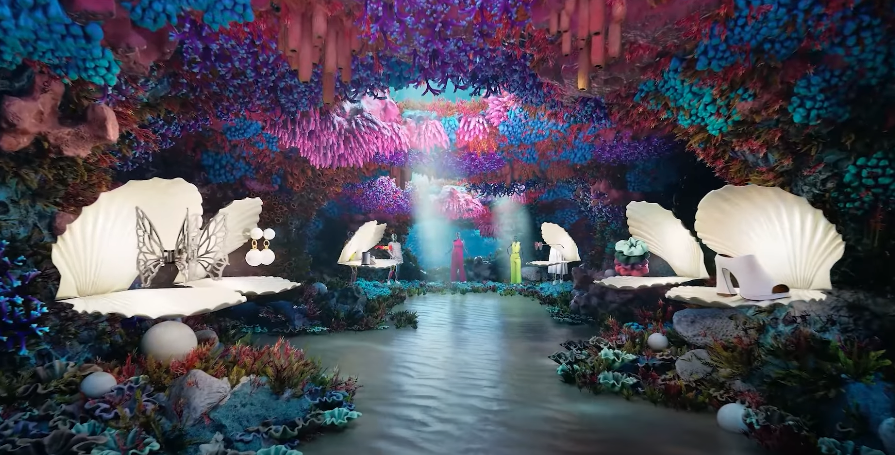Walmart on Roblox. Unilever on Fortnite. Coach on ZEPETO.
As brands try to reach more Gen Z and Gen Alpha audiences, the number of gaming brand collaborations is increasing. In fact, 558 brands entered gaming in 2024.
But just entering gaming isn’t enough. The key to success lies in choosing the right gaming platform for your brand. Each platform offers unique user experiences, demographics, and collaboration models.
By the end of this blog, you’ll be equipped to evaluate which platform aligns best with your brand’s goals and discover where to find more in-depth data to guide your decision.
Ready to explore the top platforms and expand your brand’s reach? Let’s dive in. 👇

1. Roblox
Launched in 2006, Roblox is a virtual world platform that hosts more than 50 million user-generated worlds and sees an average of 300 million monthly active users (MAU). In Q2 2024, it saw an average of 79.5 million daily active users (DAU).
What do you do on Roblox?
Rather than being one game, Roblox acts as a catalog of games that any developer can contribute to. In the same way that anyone can create an Instagram or TikTok page, anyone can create a game (also known as an ‘experience’) and create a game on the Roblox platform.
To understand what a branded Roblox experience is like from a player perspective, you can create an account and enter ‘The Brands Experience’ on Roblox.
What brands are on Roblox?
A few brands on Roblox include Amazon, Disney as well as GEEIQ partners L’Oréal and Elton John.
Why are brands on Roblox?
We asked Winnie Burke, Global Group Director of Fashion and Brand Partnerships at Roblox, why brands are on Roblox:
“There are newer opportunities for brands to treat this like their traditional marketing and understand that this is a community and an audience that they’re not reaching on other channels. Gen Z, in particular, is a very hard demographic to reach, you know? When you can get a share of their time, it’s extremely valuable.”
Why is Roblox popular with brands?
Since 2022, Roblox has consistently been the most popular platform for brand activations, also known informally as ‘brand collaborations’ or ‘brand collabs’, though brands don’t need to directly partner with Roblox to create a branded experience.
Its user-generated content (UGC) model allows brands to create custom experiences without working directly with a specific, internal Roblox developer. A brand can work with any Roblox development studio of their choice, offering them flexibility, shorter lead times, and more control over the virtual environment they develop. This makes it easier to build personalized experiences and mirror real-world product launches on Roblox than most traditional gaming platforms.
You can read more about the marketing results brands see when they activate on Roblox in our Walmart case study.

Who is Roblox’s audience?
Roblox’s audience has a nearly equal gender split, with a notable popularity among girls. In fact, 52% of Roblox’s social followers are female, totaling around 14.9 million. This sets it apart from other popular platforms, like Fortnite.
Its following is spread internationally, but Roblox is most popular in Brazil (10.2 million followers) and the United States (7.6 million followers).
Roblox is a go-to for brands aiming to target Gen Z and Gen Alpha. The majority of its players are under 24, making up over 53% of its social audience. According to Roblox in December 2023, its largest demographics are aged 17-24 (23%), 9-12 (21%), under 9 (21%), 13-16 (16%).

2. Fortnite
Launched in 2017 and owned by Epic Games, Fortnite is a popular game primarily known for its aesthetic avatars and viral dances. In 2023, the platform saw an average of 126 million active users every month.
What do you do in Fortnite?
Fortnite’s most popular game mode is ‘Battle Royale’, where up to 100 players compete to be the last person standing on a shrinking island, gathering weapons and building structures for defense and tactical advantage.
Fortnite also offers a Creative Mode where brands can create custom maps, mini-games, and other interactive elements.
What brands are on Fortnite?
GEEIQ partners Versace, NASCAR, and Ralph Lauren are just a few of the brands that have activated on Fortnite.
Why are brands on Fortnite?
Many brands know Fortnite for its high-profile collaborations, making it an attractive platform to them.
Fortnite Creative islands can experience large spikes of visitors after launch. However, this decreases significantly after a week. Nike’s ‘Airphoria’ experience, for example, received a lot of PR attention and saw 22.3k average players on the first day it launched – an impressive number for a Fortnite Creative experience. However, by the seventh day of its activation, this number had dropped to 2.2k.
In 2025, Epic Games launched its Fortnite Data API, giving brands unprecedented access to key performance metrics like active players, retention, session time, and visit volume. And platforms like GEEIQ have already integrated this API to make Fortnite data actionable for marketers.
This new level of visibility is already shifting strategy. Brands now have the tools to measure what’s working, iterate campaigns in real time, and justify continued investment. In short, this new data incentivizes brands to treat Fortnite as a performance-driven marketing channel — not just a PR play.

Who plays Fortnite?
Fortnite’s audience is primarily aged 25-29, with this age group representing over 56% of its social audience.
The Fortnite social audience over-indexes male (1.12x), with 66.6 million (89%) male followers.
Its audience is split largely between the United States (45.9 million followers), United Kingdom (10.9 million followers), and then Mexico (2.2 million followers).

3. ZEPETO
Launched in 2018, GEEIQ partner ZEPETO is a South Korean virtual world and social networking platform created by Naver Z. It is focused on self-expression via 3D avatars that can interact in different environments. It sees around 20 million monthly active users.
GEEIQ’s partnership with ZEPETO allows brands activating on ZEPETO to measure success and evaluate ROI, including player engagement and item sales, on GEEIQ’s platform.
What do you do in ZEPETO?
Players can dress their avatar and interact by posting content or chatting via text or voice. ZEPETO hosts virtual spaces where players can share their avatar selfies and play interactive games.
Like social media platforms such as TikTok, ZEPETO features a video feed where players can like, comment on, and share content. This feed often reflects current social trends on TikTok or Instagram Reels.
What brands are on ZEPETO?
Since 2019, over 100 brands have activated on ZEPETO, including GEEIQ partners Walmart, Gucci, L’Oréal, LVMH and Coach.
Why are brands on ZEPETO?
Heesuk Ricky Kang, Head of Business Development and Partnerships at Naver Z, explained why more brands are activating on platforms like ZEPETO:
“We’ve seen the cost of entry go down. At the same time, studios and agencies have established a deep knowledge base of what works and what doesn’t. They’ve become more efficient when it comes to creating, learning about virtual spaces, and working out what gets the most ROI.”
ZEPETO’s avatar-driven setup is also great for brands with a self-expression focus that are looking to be part of a users’ virtual identity. By creating brand-specific items and immersive spaces, you can drive engagement and build affinity in a highly social, trend-focused environment. For example, Coach recently launched a series of virtual items and a virtual booth in ZEPETO.

Who plays ZEPETO?
The ZEPETO social audience significantly over-indexes female (3.5x) versus the average platform. The platform’s social audience is 72% female, with over 2.6 million female followers.
They are also most likely to be under 24, with this age group representing 62% of the social audience.
This platform works particularly well for brands looking to target Asian audiences, as ZEPETO has a large social following in Thailand (One million followers) and Indonesia (555k followers). That being said, its following in the United States and Brazil is steadily increasing.

4. Minecraft
Launched in 2011, Minecraft is a sandbox platform that allows players to explore, create, and survive in blocky, generated worlds. Most estimates place Minecraft at around 170 million monthly active users.
What do you do in Minecraft?
Minecraft has three core game modes:
- Survival – gather resources, build shelter, and fend off monsters.
- Creative – unlimited resources for building and exploration.
- Adventure – play custom maps created by other players.
Minecraft’s active community develops mods, custom maps, and other content, making it a versatile game that has remained popular for over 13 years.
What brands are in Minecraft?
Some of the brands that entered Minecraft in 2024 include Nestlé, Knorr, and DreamWorks Animation.
Why are brands on Minecraft?
For brands, Minecraft provides a rich canvas for building imaginative campaigns and connecting with an engaged, younger audience. However, there’s a higher barrier to entry when it comes to activating within the platform as Minecraft is not an open UGC platform.
We spoke to George Ditch, Product Development Manager at GEEIQ, about why brands are on Minecraft:
“Minecraft is iconic. Whilst it is more difficult for brands to activate in Minecraft, the recent release of the Minecraft Marketplace Pass points towards an attitude shift at Mojang/Microsoft to make their game more comparable to UGC platforms like Roblox.”

Who plays Minecraft?
Minecraft’s audience is predominantly male, with 28.7 million male followers (64%). However, compared to other platforms, Minecraft has strong female representation, over-indexing on female followers by x1.7.
Its players are also most likely to be under 24, with this age group representing over 72% of the social audience.
Minecraft is most popular in the United States (18.7 million followers), followed by Brazil (6 million followers).

5. Rec Room
Launched in 2016, Rec Room is a 3D social hangout platform that was initially focused on its compatibility with Apple Vision Pro, but has become available across console, mobile and desktop.
What do you do in Rec Room?
The platform features a variety of activities, such as paintball, dodgeball, and escape rooms, along with spaces for more relaxed interactions like chatting, hanging out, and participating in community events.
It’s designed to be a creative and social space, offering tools for users to customize their environments and share them with others.
What brands are on Rec Room?
Paramount, the NFL, and Mattel have previously activated in Rec Room.
Lauren Mettler, Head of Business Development and Partnerships at Rec Room, spoke to us about what kind of brands are entering the platform:
“It leans more towards Media & Entertainment for now. We have had some really great partnerships with Barbie and Teen Mutant Ninja Turtles. Destiny 2 was another big activation we did this year. But we also had Puma and are still seeing fashion brands wanting to explore multiple platforms.”
Why are brands on Rec Room?
Brands enter Rec Room for its focus on user-generated rooms and social games. These offer a unique opportunity to create branded experiences that feel organic and community-oriented.

Who plays Rec Room?
72% of Rec Room’s social audience is male, making up 1.5 million followers.
They are most likely to be aged 35-44, with this age group representing 35% of the social audience.
Its audience is split largely between the United States (1.5 million) and the United Kingdom (211.2k followers).

6. Emperia & Obsess
Emperia and Obsess are virtual reality platforms that allow brands to create VR-compatible shops. Consumers can enter these spaces online or using a headset, like the Apple Vision Pro.
What do you do in a virtual store?
Virtual stores can serve as a way to provide the convenience and personalization of e-commerce while still delivering the experience, immersion, and product interaction you would experience in-store.
Tom von Simson, one of the virtual strategy experts behind Walmart entering Emperia, explains what it’s like to enter a virtual shop:
“It’s essentially an e-commerce site, except it’s a 3D environment – like a video game where you’re walking around and there’s a 3D landscape around you. You’re able to see products in 3D, you’re able to understand more about the dimensions. There are some instances in VR or augmented reality where you can view products inside your home.”
What brands have used Emperia or Obsess?
GEEIQ partners Walmart, and BOSS have both activated on Emperia this year. Ralph Lauren, RIMOWA, and alo have created Obsess virtual shops.
Why do brands create virtual stores?
These spaces are often popular with brands for their ecommerce offering and high fidelity. The product rendering in these spaces is highly realistic and reflective of texture, print, and material in real life.
Brands have found that the adoption of VR in e-commerce can increase online shopping conversion by 17%, which is significantly higher than the average e-comm conversion rate of around 2%. Shopping with virtual try-on and AR based experiences leads to a 94% higher conversion rate.
These experiences are fully owned by the brand rather than hosted on platforms like Roblox or Fortnite, allowing brands to embed them directly on their website and customize them with their branding.
Who shops in virtual stores?
It depends on who the brand is targeting and where they host these virtual shops.
Unlike gaming platforms such as Fortnite or Roblox, virtual shops don’t offer as many social features for interacting with other shoppers. Consequently, the visitor traffic to these spaces relies on the partners or paid media channels that brands use to attract audiences.
Key Takeaways
Selecting the right gaming platform can make all the difference in driving brand engagement, awareness, and loyalty in the virtual world. Each platform offers unique features and audiences. Roblox and Fortnite provide highly social, customizable experiences with young, active user bases. Other platforms, like Emperia and Obsess, focus on immersive, controlled shopping environments suited for conversion.
For brand marketers, understanding the options available to you are essential.
Then, the next step is to narrow down which platform is the right gaming platform for your brand. Choose a platform that aligns with your brand’s objectives, target audience, and marketing KPIs. the audience you want to reach, and the level of interactivity your campaign requires. With the right platform choice, virtual worlds can become powerful avenues for meaningful brand connections.
Not sure where to start? Book a quick consultation with our team to scope out whether virtual worlds are right for you and get more in-depth data from virtual worlds.
Get started below 👇